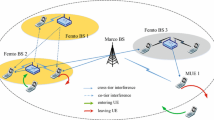Abstract
This paper investigates a mobile communication network of N-cells in tandem, in which mobile terminals move in a unidirection and the channel holding time of calls at each cell is assumed to have phase type distributions of order-2. We develop an approximate method to obtain main performances of systems such as the loss probabilities of handover calls and fresh calls, and the expected number of occupied channels in each node. Our approximation is based on decomposing the N cells in tandem into N−1 pairs of cells with overlap. The stochastic correlations among the neighbouring pairs are captured by aid of the state-dependent Poisson input processes. We give examples to demonstrate the accuracy and the convergence properties of the proposed approximation.
Similar content being viewed by others
References
A.S. Alfa and B. Liu, Performance analysis of a mobile communication network: The tandem case, Research Report, Department of IMSE, University of Windsor (2000) submitted for publication.
F. Barcelo and J. Jordan, Channel holding time distribution in public cellular telephony, in: Proc. of the 16th Internat. Teletraffic Congress, 1999, pp. 107–116.
R.J. Boucherie and M. Mandjes, Estimation of performance measures for product form cellular mobile communications networks, Telecommunication Systems 10 (1998) 321–354.
R.J. Boucherie and N.M. Van Dijk, On a queueing network model for cellular mobile telecommuni-cations networks, Operations Research 48(1) (2000) 38–49.
A. Brandwajn and Y.L. Jow, An approximation method for tandem queues with blocking, Operations Research 36(1) (1988) 73–83.
D. Everitt, Traffic engineering of the radio interface for cellular mobile networks, Proceedings of the IEEE 82 (1994) 1371–1382.
D. Everitt and N.W. Macfadyen, Analysis of multi-cellular mobile radiotelephone systems with loss, British Telecom Technical Journal 1 (1983) 218–222.
D. Everitt and D. Manfield, Performance analysis of cellular mobile communication systems with dynamic channel assignment, IEEE Journal on Selected Areas in Communications 7 (1989) 1172–1180.
Y. Fang and I. Chlamtac, Teletraffic analysis and mobility modeling of PCS networks, IEEE Transactions on Communications 47(7) (1999) 1062–1072.
R.A. Guerin, Channel occupancy time distribution in a cellular radio system, IEEE Transactions on Vehicular Technology 35(3) (1987) 89–99.
C. Jedrzycki and V.C.M. Leung, Probability distribution of channel holding time in cellular telephony systems, in: IEEE Vehicular Technology Conference VTC'96, 1996, pp. 247–251.
A. Lang and J.L. Arthur, Parameter approximation for phase-type distributions, in: Matrix-Analytic Methods in Stochastic Models, eds. S.R. Chakravarthy and A.S. Alfa (Marcel Dekker, New York, 1996).
K.K. Leung, W.A. Massey and W. Whitt, Traffic models for wireless communication networks, IEEE Journal on Selected Areas in Communications 12(8) (1994) 1353–1364.
W. Li and A.S. Alfa, A PCS network with correlated arrival process and splitted-rating channels, IEEE Journal on Selected Areas in Communications 17(7) (1999) 1318–1325.
W. Li and A.S. Alfa, Channel reservation for handoff calls in a PCS network, IEEE Transactions on Vehicular Technology 49(1) (1999) 1318–1325.
W.A. Massey and W. Whitt, A stochastic model to capture space and time dynamics in wireless communication systems, Probability in Engineering and Information Science 8 (1994) 541–569.
D. McMillan, Traffic modeling and analysis for cellular mobile networks, in: Proc. of the 13th Internat.Teletraffic Congress, 1991, pp. 627–632.
P.V. Orlik and S.S. Rappaport, A model for teletraffic performance and channel holding time characterization in wireless cellular communication with general session and dwell time distributions, IEEE Journal on Selected Areas in Communications 16(5) (1998) 788–803.
D.L. Pallant and P.G. Taylor, Approximations of performance measures in cellular mobile networks with dynamic channel allocation, Telecommunication Systems 3 (1994) 319–163.
D.L. Pallant and P.G. Taylor, Modelling handovers in cellular mobile networks with dynamic channel allocation, Operations Research 43(1) (1995) 33–42.
M. Sidi and D. Starobinski, New call blocking versus handoff blocking in cellular networks, Wireless Networks 3 (1997) 15–27.
B.H. Soong and J.A. Barria, A Coxian model for channel holding time distribution for teletraffic mobility modeling, IEEE Communications Letters 4(12) (2000) 402–404.
Author information
Authors and Affiliations
Rights and permissions
About this article
Cite this article
Alfa, A.S., Liu, B. Performance Analysis of a Mobile Communication Network: Unidirectional Tandem Case with Phase Type Service. Telecommunication Systems 20, 241–254 (2002). https://doi.org/10.1023/A:1016593111704
Issue Date:
DOI: https://doi.org/10.1023/A:1016593111704




